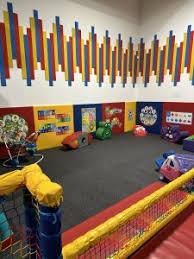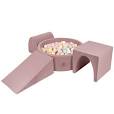
Exploring the Magic of Indoor Children’s Play
Exploring the Benefits of Indoor Play for Children
Indoor play is not just a way to keep children entertained on rainy days; it also offers a host of benefits for their development and well-being. In today’s fast-paced world, where screen time often dominates children’s activities, indoor play provides a valuable opportunity for them to engage in active, imaginative, and social play.
Physical Health
Indoor play spaces offer a safe environment for children to engage in physical activity, which is crucial for their overall health and development. Climbing structures, ball pits, and obstacle courses encourage children to move their bodies, improve coordination, and build strength. Regular physical activity can help prevent childhood obesity and promote a healthy lifestyle.
Cognitive Development
Indoor play stimulates children’s cognitive abilities by encouraging problem-solving, creativity, and critical thinking. Building blocks, puzzles, and pretend play activities help develop spatial awareness, fine motor skills, and logical thinking. Through imaginative play, children can explore different roles and scenarios, fostering their creativity and expanding their understanding of the world around them.
Social Skills
Playing indoors with other children provides valuable opportunities for social interaction and communication. It teaches children important skills such as sharing, taking turns, cooperation, and conflict resolution. By engaging in group activities and games, children learn how to work together towards common goals and develop empathy towards others.
Emotional Well-being
Indoor play can also have a positive impact on children’s emotional well-being by providing them with an outlet for self-expression and stress relief. Play allows children to express their emotions freely in a safe environment without fear of judgment. It helps them build confidence, resilience, and self-esteem as they navigate challenges and overcome obstacles during play.
Conclusion
Indoor play is an essential component of every child’s development journey. By providing a stimulating environment that promotes physical activity, cognitive growth, social interaction, and emotional well-being, indoor play spaces offer countless benefits that contribute to the holistic development of children. So next time you’re looking for ways to keep your child engaged and happy indoors – consider the many advantages that indoor play has to offer!
Essential FAQs for Enhancing Indoor Play for Children
- What are the benefits of indoor play for children?
- How can I make indoor play more engaging for my child?
- What types of activities are best for indoor play?
- Are there any safety concerns with indoor play areas?
- How much time should children spend on indoor play versus outdoor activities?
- Can indoor play help with my child’s social skills development?
- What equipment or toys are essential for a good indoor play space?
- How can I create an effective and fun indoor play area at home?
What are the benefits of indoor play for children?
Indoor play for children offers a multitude of benefits that contribute to their overall development and well-being. Engaging in indoor play activities helps children improve their physical health by encouraging movement, coordination, and strength-building in a safe environment. Additionally, indoor play stimulates cognitive development through problem-solving, creativity, and imaginative play, fostering important skills such as spatial awareness and logical thinking. Socially, indoor play promotes interaction with peers, teaching valuable lessons in sharing, cooperation, and empathy. Moreover, indoor play provides children with an outlet for self-expression and emotional growth, helping them build confidence and resilience. In essence, the benefits of indoor play for children extend far beyond mere entertainment – it is a vital component of their holistic growth and learning experience.
How can I make indoor play more engaging for my child?
To make indoor play more engaging for your child, consider incorporating a variety of activities that cater to their interests and abilities. Create themed play areas, such as a pretend kitchen or a construction zone, to spark their imagination. Rotate toys and games regularly to keep things fresh and exciting. Encourage open-ended play by providing materials like building blocks, art supplies, or dress-up costumes that allow for creativity and exploration. Engage in interactive play with your child, whether it’s through storytelling, role-playing, or cooperative games. Remember that the key is to make indoor playtime fun, interactive, and tailored to your child’s preferences to keep them entertained and engaged for hours on end.
What types of activities are best for indoor play?
When it comes to indoor play for children, the types of activities that are best suited are those that engage their minds and bodies in a fun and stimulating way. Activities such as building with blocks, solving puzzles, engaging in pretend play, arts and crafts, interactive games, and physical activities like dancing or yoga can all provide a well-rounded indoor play experience. These activities not only promote creativity, problem-solving skills, and physical development but also encourage social interaction and emotional expression. By offering a variety of activities that cater to different interests and abilities, parents can create an enriching indoor play environment that keeps children entertained and engaged for hours on end.
Are there any safety concerns with indoor play areas?
Safety is a top priority in indoor play areas to ensure that children can have fun in a secure environment. While indoor play spaces are designed with safety in mind, there are still some concerns that parents should be aware of. Common safety considerations include proper supervision to prevent accidents, regular maintenance of equipment to ensure it is in good condition, and age-appropriate activities to minimise risks. It’s important for parents to be vigilant and teach their children about safe play practices, such as taking turns and following rules. By being proactive and attentive, families can enjoy the benefits of indoor play areas while minimising potential safety hazards.
How much time should children spend on indoor play versus outdoor activities?
Determining the ideal balance between indoor play and outdoor activities for children is a common concern among parents and caregivers. While both indoor and outdoor play offer unique benefits, experts generally recommend that children engage in a mix of both environments for holistic development. The specific amount of time spent on indoor play versus outdoor activities may vary depending on factors such as age, weather conditions, safety considerations, and individual preferences. It’s important to strike a balance that allows children to benefit from the physical activity, social interaction, creativity, and sensory experiences offered by both indoor and outdoor environments. Ultimately, prioritising a diverse range of play opportunities can help children thrive and enjoy a well-rounded childhood experience.
Can indoor play help with my child’s social skills development?
Indoor play can indeed play a significant role in enhancing your child’s social skills development. By engaging in activities with other children in a controlled and supervised environment, your child has the opportunity to practice important social interactions such as sharing, taking turns, cooperation, and communication. Through group play and collaborative games, children learn how to navigate social dynamics, resolve conflicts, and work towards common goals – all of which are essential skills for building strong relationships and thriving in social settings. Indoor play provides a safe space for your child to learn and grow socially, fostering empathy, teamwork, and a sense of community that will benefit them both now and in the future.
What equipment or toys are essential for a good indoor play space?
When creating a good indoor play space for children, the choice of equipment and toys is crucial to ensure a fun and engaging environment. Essential items include versatile play structures like climbing frames, slides, and tunnels that encourage physical activity and exploration. Interactive toys such as building blocks, puzzles, and art supplies stimulate cognitive development and creativity. Soft play areas with cushions or mats provide a safe space for active play and relaxation. Additionally, pretend play props like costumes, dolls, and toy kitchen sets promote imaginative role-playing activities. By incorporating a variety of equipment and toys that cater to different interests and developmental needs, an indoor play space can offer endless opportunities for children to learn, grow, and have fun.
How can I create an effective and fun indoor play area at home?
Creating an effective and fun indoor play area at home is a great way to keep children entertained and engaged, especially during unfavourable weather or when outdoor play is limited. To set up a successful indoor play space, consider incorporating a variety of activities and toys that cater to different interests and age groups. Utilise versatile items like building blocks, puzzles, art supplies, and pretend play props to encourage creativity and cognitive development. Incorporating soft mats or carpets for physical play, such as rolling or tumbling, can also make the area safe and comfortable for active play. Additionally, designating a specific area for the play zone can help establish boundaries and promote organisation. By creating a stimulating environment that combines educational value with fun elements, you can ensure that your indoor play area becomes a favourite spot for your child’s entertainment and growth.


